| Area |
Anderson Creek |
| Topic |
Tour: Restoration Tebbutt's Before/After 1984-2001 #1 |
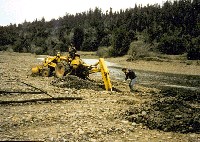 Click on image to enlarge (46K). Click here to display a larger version (205K).
Click on image to enlarge (46K). Click here to display a larger version (205K).This photo shows Chris Tebbutt hard at work deep planting cottonwood and willows in 1984. The black branches at left are fence post-sized are black willows. See Pictures #2-3 for 1986 and 2003. Photo by Chris Tebbutt.
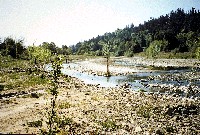 Click on image to enlarge (62K). Click here to display a larger version (272K).
Click on image to enlarge (62K). Click here to display a larger version (272K).Two years later the outside curve of Anderson Creek on the Tebbutt property is unprotected but the trees are growing. The stream channel in 1986 shifted into planted areas. After 15 more years of bioengineering, see Picture #3 for completely restored riparian zone. Photo by Chris Tebbutt.
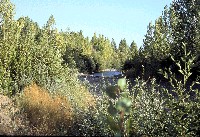 Click on image to enlarge (60K). Click here to display a larger version (255K).
Click on image to enlarge (60K). Click here to display a larger version (255K).Cottonwoods, willows and alders line both banks of Anderson Creek in this photo taken looking upstream on the Tebbutt property in spring 2001. Many trees seen at left are actually rooted in vegetated hard points with massive rock structures. Deep planting of cottonwoods was used on both sides of the creek. Photo by Chris Tebbutt. 2001.
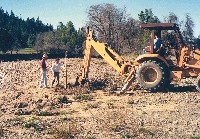 Click on image to enlarge (46K). Click here to display a larger version (222K).
Click on image to enlarge (46K). Click here to display a larger version (222K).This photo was taken looking downstream on the Tebbutt property in 1984, with Chris Tebbutt planting cottonwoods in holes dug by a backhoe. Trees were planted experimentally on the active gravel bar, which was 325 feet wide at the time. Note the mature hardwood tree nearest in the photo behind the backhoe for reference in 2001 (Pictures #5-6). Photo by Chris Tebbutt.
 Click on image to enlarge (38K). Click here to display a larger version (176K).
Click on image to enlarge (38K). Click here to display a larger version (176K).Note the tree to the left of center in the photo, which was also behind the backhoe in Picture #4. Vegetated hard points are masked by vegetation and the stream has scoured modest pools where it was formerly a riffle. This area is completely restored. The trees in the riparian zone in this March 2001 photo are dormant, but see Picture #6 for the fully leafed condition later in the year. Photo by Pat Higgins
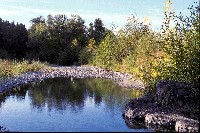 Click on image to enlarge (51K). Click here to display a larger version (238K).
Click on image to enlarge (51K). Click here to display a larger version (238K).The restored riparian zone of Anderson Creek in summer 2001 protects valuable agricultural land. Newly installed vegetated hard points are visible at right and have not yet been covered by vegetation but have already created a scour pool for steelhead rearing. This pool remained during low flow conditions when much of Anderson Creek was dewatered. Photo by Chris Tebbutt. 2001.
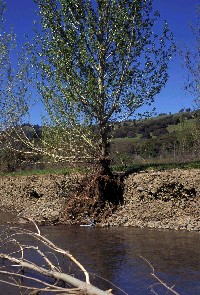 Click on image to enlarge (55K). Click here to display a larger version (254K).
Click on image to enlarge (55K). Click here to display a larger version (254K).This tree along the downstream reach of Anderson Creek on the Tebbutt property was almost washed away by the high water of January 1, 1997. See Picture #8 for the same tree, but behind with protection of a rock basket structure or vegetated hard point in 2001. Photo by Chris Tebbutt.
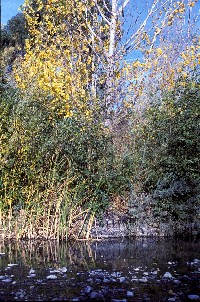 Click on image to enlarge (75K). Click here to display a larger version (324K).
Click on image to enlarge (75K). Click here to display a larger version (324K).The tree behind the rock basket is the same as in Picture #7. The vegetated hard point installed in front of it not only protects it but slows the flow of Anderson Creek and recruits soil. The cottonwood and other riparian trees then bind it with their roots. This reduces sediment transport by catching soil already unleashed from uplands. Photo by Chris Tebbutt.
To learn more about this topic click Info Links
To view additional information (data source, aquisition date etc.) about this page, click Metadata
 Click on image to enlarge (46K). Click here to display a larger version (205K).
Click on image to enlarge (46K). Click here to display a larger version (205K). Click on image to enlarge (62K). Click here to display a larger version (272K).
Click on image to enlarge (62K). Click here to display a larger version (272K). Click on image to enlarge (60K). Click here to display a larger version (255K).
Click on image to enlarge (60K). Click here to display a larger version (255K). Click on image to enlarge (46K). Click here to display a larger version (222K).
Click on image to enlarge (46K). Click here to display a larger version (222K). Click on image to enlarge (38K). Click here to display a larger version (176K).
Click on image to enlarge (38K). Click here to display a larger version (176K). Click on image to enlarge (51K). Click here to display a larger version (238K).
Click on image to enlarge (51K). Click here to display a larger version (238K). Click on image to enlarge (55K). Click here to display a larger version (254K).
Click on image to enlarge (55K). Click here to display a larger version (254K). Click on image to enlarge (75K). Click here to display a larger version (324K).
Click on image to enlarge (75K). Click here to display a larger version (324K).